Removal Efficiency of Sulfapyridine from Contaminated Surface Water by Carboxylated Graphene Oxide Blended PVDF Composite Ultrafiltration Membrane with Activated Carbon
Abstract
1. Introduction
2. Materials and Methods
2.1. Materials and Reagents
2.2. Preparation of Carboxyl-Functionalized Graphene Oxide
2.3. Preparation of PVDF/CFGO Ultrafiltration Membrane
2.4. BBD Response Surface Optimization Design
2.5. Determination of Pure Water Flux of Membranes
2.6. Membrane Performance for Sulfapyridine Removal
2.7. SPY Removal Rate of Ultrafiltration Membrane Combined with Activated Carbon
3. Results and Discussion
3.1. Preparation of PVDF Composite Ultrafiltration Membrane and Response Surface Analysis
3.1.1. Significance Test
3.1.2. Response Surface Analysis
B + 1300.25 × A × C − 990.58 × A × D + 117.50 × B × C − 173.97 × B × D + 903.89 ×
C × D + 656.53 × A2 − 589.65 × B2 − 650.05 × C2 + 443.50 × D2
C − 0.12 × A × D + 0.66 × B × C + 0.46 × B × D + 0.11 × C × D − 2.39 × A2 −2.26 ×
B2 − 7.15 × C2 − 3.06 × D2
× C − 0.23 × A × D + 0.29 × B × C − 0.94 × B × D + 1.01 × C × D − 1.82 × A2 −
2.98 × B2 − 7.45 × C2 −2.96 × D2
3.2. Morphology of CFGO/PVDF Ultrafiltration Membranes
3.3. Infrared Analysis of Membranes
3.4. Contact Angle of Membrane Surface
3.5. Membrane Performance Analysis
3.5.1. Pure Water Flux of Membrane
3.5.2. Analysis of Membrane Performance for Sulfapyridine Removal from Water
4. Conclusions
Author Contributions
Funding
Data Availability Statement
Acknowledgments
Conflicts of Interest
References
- Russell, J.N.; Yost, C.K. Alternative, Environmentally Conscious Approaches for Removing Antibiotics from Wastewater Treatment Systems. Chemosphere 2020, 263, 128177. [Google Scholar] [CrossRef]
- Wang, H.; Lou, X.; Hu, Q.; Sun, T. Adsorption of antibiotics from water by using Chinese herbal medicine residues derived biochar: Preparation and properties studies. J. Mol. Liq. 2020, 325, 114967. [Google Scholar] [CrossRef]
- Barbooti, M.M.; Zahraw, S.H. Removal of Amoxicillin from Water by Adsorption on Water Treatment Residues. Baghdad Sci. J. 2020, 17, 1071. [Google Scholar] [CrossRef]
- Luo, B.; Huang, G.; Yao, Y.; An, C.; Zhang, P.; Zhao, K. Investigation into the influencing factors and adsorption characteristics in the removal of sulfonamide antibiotics by carbonaceous materials. J. Clean. Prod. 2021, 319, 128692. [Google Scholar] [CrossRef]
- Zuo, X.; Qian, C.; Ma, S.; Xiong, J.; He, J.; Chen, Z. Removal of sulfonamide antibiotics from water by high-silica ZSM-5. Water Sci. Technol. 2019, 80, 507–516. [Google Scholar] [CrossRef]
- Ingerslev, F.; Halling-Srensen, B. Biodegradability properties of sulfonamides in activated sludge. Environ. Toxicol. Chem. 2000, 19, 2467–2473. [Google Scholar] [CrossRef]
- Adams, C.; Wang, Y.; Loftin, K.; Meyer, M. Removal of antibiotics from surface and distilled water in conventional water treatment processes. J. Environ. Eng. 2002, 128, 253–260. [Google Scholar] [CrossRef]
- Du, X.; Yang, W.; Liu, Y.; Zhang, W.; Wang, Z.; Nie, J.; Li, G.; Liang, H. Removal of manganese, ferrous and antibiotics from groundwater simultaneously using peroxymonosulfate-assisted in-situ oxidation/coagulation integrated with ceramic membrane process. Sep. Purif. Technol. 2020, 252, 117492. [Google Scholar] [CrossRef]
- Fu, W.; Bing, L.; Yang, J.; Yi, H.; Chai, L.; Li, X. New insights into the chlorination of sulfonamide: Smiles-type rearrangement, desulfation, and product toxicity. Chem. Eng. J. 2018, 331, 785–793. [Google Scholar] [CrossRef]
- Huang, B.-Q.; Tang, Y.J.; Zeng, Z.-X.; Xue, S.-M.; Li, S.-Q.; Wang, Y.-R.; Li, E.-C.; Tang, C.Y.; Xu, Z.-L. Enhancing nanofiltration performance for antibiotics/NaCl separation via water activation before microwave heating. J. Membr. Sci. 2021, 629, 119285. [Google Scholar] [CrossRef]
- Zhang, L.; Huang, J.; Xiong, D. Desalination of Nanofiltration Membranes and its Application in Seawater Softening. Membr. Sci. Technol. 2012, 32, 97–101. [Google Scholar]
- Othman, M.; Adam, M.R.; Pauzan, M. Ultrafiltration Membrane for Water Treatment; Springer: Cham, Switzerland, 2019. [Google Scholar]
- Yan, C. Application of Ultrafiltration Membrane to Water Treatment. Guizhou Chem. Ind. 2006. [Google Scholar]
- Arcanjo, G.S.; Dos Santos, C.R.; Cavalcante, B.F.; Moura, G.A.; Ricci, B.C.; Mounteer, A.H.; Santos, L.V.S.; Queiroz, L.M.; Amaral, M.C. Improving biological removal of pharmaceutical active compounds and estrogenic activity in a mesophilic anaerobic osmotic membrane bioreactor treating municipal sewage. Chemosphere 2022, 301, 134716. [Google Scholar] [CrossRef] [PubMed]
- Bai, R.; Zhu, X. Separation of biologically active compounds by membrane operations. Curr. Pharm. Des. 2017, 23, 218–230. [Google Scholar]
- Zhou, A.; Jia, R.; Wang, Y.; Sun, S.; Xin, X.; Wang, M.; Zhao, Q.; Zhu, H. Abatement of sulfadiazine in water under a modified ultrafiltration membrane (PVDF-PVP-TiO2-dopamine) filtration-photocatalysis system. Sep. Purif. Technol. 2020, 234, 116099. [Google Scholar] [CrossRef]
- Huang, G.; Shi, J.X.; Langrish, T. Removal of Cr(VI) from aqueous solution using activated carbon modified with nitric acid. Chem. Eng. J. 2009, 152, 434–439. [Google Scholar] [CrossRef]
- Daud, W.M.A.W.; Houshamnd, A.H. Textural characteristics, surface chemistry and oxidation of activated carbon. J. Nat. Gas Chem. 2010, 19, 267–279. [Google Scholar] [CrossRef]
- Abdelrhman, Y.; Heshmat, M. ANOVA and regression model of slurry erosion parameters of a polymeric spray paint film. Int. J. Mater. Eng. Innov. 2020, 11, 198. [Google Scholar] [CrossRef]
- Yuan, H.; Jin, L.; Luo, D.; Ge, C. Modification Effect of Nano-Graphene Oxide on Properties and Structure of Polysulfone Ultrafiltration Membrane. J. Environ. Prot. 2018, 9, 1185. [Google Scholar] [CrossRef]
- Zhao, Y.; Lu, J.; Liu, X.; Wang, Y.; Lin, J.; Peng, N.; Li, J.; Zhao, F. Performance enhancement of polyvinyl chloride ultrafiltration membrane modified with graphene oxide. J. Colloid Interface Sci. 2016, 480, 1–8. [Google Scholar] [CrossRef]
- Xu, P.; Hong, J.; Qian, X.; Xu, Z.; Xia, H.; Ni, Q.-Q. “Bridge” graphene oxide modified positive charged nanofiltration thin membrane with high efficiency for Mg2+/Li+ separation. Desalination 2020, 488, 114522. [Google Scholar] [CrossRef]
- Xue, J.; Wang, S.; Han, X.; Wang, Y.; Li, J. Prepartion and separation performance of GO modified PVDF ultrafiltration membrane. CIESC J. 2017, 68, 3466–3473. [Google Scholar]
- Qin, J.J.; Wong, F.S.; Ying, L.; Liu, Y.-T. A high flux ultrafiltration membrane spun from PSU/PVP (K90)/DMF/1,2-propanediol. J. Membr. Sci. 2003, 211, 139–147. [Google Scholar] [CrossRef]
- Irfan, M.; Basri, H.; Irfan, M.; Lau, W.-J. Acid functionalized MWCNT/PVP nanocomposite as new additive for fabrication of ultrafiltration membrane with improved anti-fouling resistance. Rsc. Adv. 2015, 5, 12. [Google Scholar] [CrossRef]
- Kaleekkal, N.J.; Thanigaivelan, A.; Rana, D.; Mohan, D. Studies on carboxylated graphene oxide incorporated polyetherimide mixed matrix ultrafiltration membranes. Mater. Chem. Phys. 2016, 186, 146–158. [Google Scholar] [CrossRef]
- Xing, R.; Wang, W.; Jiao, T.; Ma, K.; Zhang, Q.; Hong, W.; Qiu, H.; Zhou, J.; Zhang, L.; Peng, Q. Bioinspired Polydopamine Sheathed Nanofibers Containing Carboxylate Graphene Oxide Nanosheet for High-Efficient Dyes Scavenger. ACS Sustain. Chem. Eng. 2017, 5, 4948–4956. [Google Scholar] [CrossRef]
- Tong, Y.; Huang, L.; Zuo, C. Novel PVDF- g -NMA Copolymer for Fabricating the Hydrophilic Ultrafiltration Membrane with Good Antifouling Property. Ind. Eng. Chem. Res. 2020, 60, 541–550. [Google Scholar] [CrossRef]
- Grünig, L.; Handge, U.A.; Koll, J.; Gronwald, O.; Weber, M.; Hankiewicz, B.; Scharnagl, N.; Abetz, V. Hydrophilic Dual Layer Hollow Fiber Membranes for Ultrafiltration. Membranes 2020, 10, 143. [Google Scholar] [CrossRef]
- Alayande, A.B.; Obaid, M.; Yu, H.-W.; Kim, I.S. High-flux ultrafiltration membrane with open porous hydrophilic structure using dual pore formers. Chemosphere 2019, 227, 662–669. [Google Scholar] [CrossRef]
- Tang, L.; Lu, Y.; Yao, L.; Cui, P. A highly hydrophilic benzenesulfonic-grafted graphene oxide-based hybrid membrane for ethanol dehydration. RSC Adv. 2020, 10, 20358–20367. [Google Scholar] [CrossRef]
- Liu, H.; Liu, X.; Zhao, F.; Liu, Y.; Liu, L.; Wang, L.; Geng, C.; Huang, P. Preparation of a hydrophilic and antibacterial dual function ultrafiltration membrane with quaternized graphene oxide as a modifier. J. Colloid Interface Sci. 2020, 562, 182–192. [Google Scholar] [CrossRef] [PubMed]
- Wang, D.-W.; Song, Y.-X.; Ye, Q.-F.; Qian, G.; Wang, S.-Y.; Cheng, Z. Study on Adsorption of Two Sulfonamide Antibiotics by Graphene Oxide. Chin. J. Anal. Chem. 2018, 46, 211–216. [Google Scholar]
- Liu, X.; Wan, Y.; Liu, P.; Lei, Z.; Weihua, Z. Preparation of activated carbon optimized by RSM from SP and the adsorption behavior for sulfonamide antibiotics. New Chem. Mater. 2019, 47, 240–243. [Google Scholar]
- Košutić, K.; Dolar, D.; Ašperger, D.; Kunst, B. Removal of antibiotics from a model wastewater by RO/NF membranes. Sep. Purif. Technol. 2007, 53, 244–249. [Google Scholar] [CrossRef]
- Ge, X.; Wu, Z.; Manzoli, M.; Bonelli, B.; Mantegna, S.; Kunz, W.; Cravotto, G. Adsorptive decontamination of antibiotic-spiked water and milk using commercial and modified activated carbons. J. Environ. Chem. Eng. 2021, 9, 105544. [Google Scholar] [CrossRef]
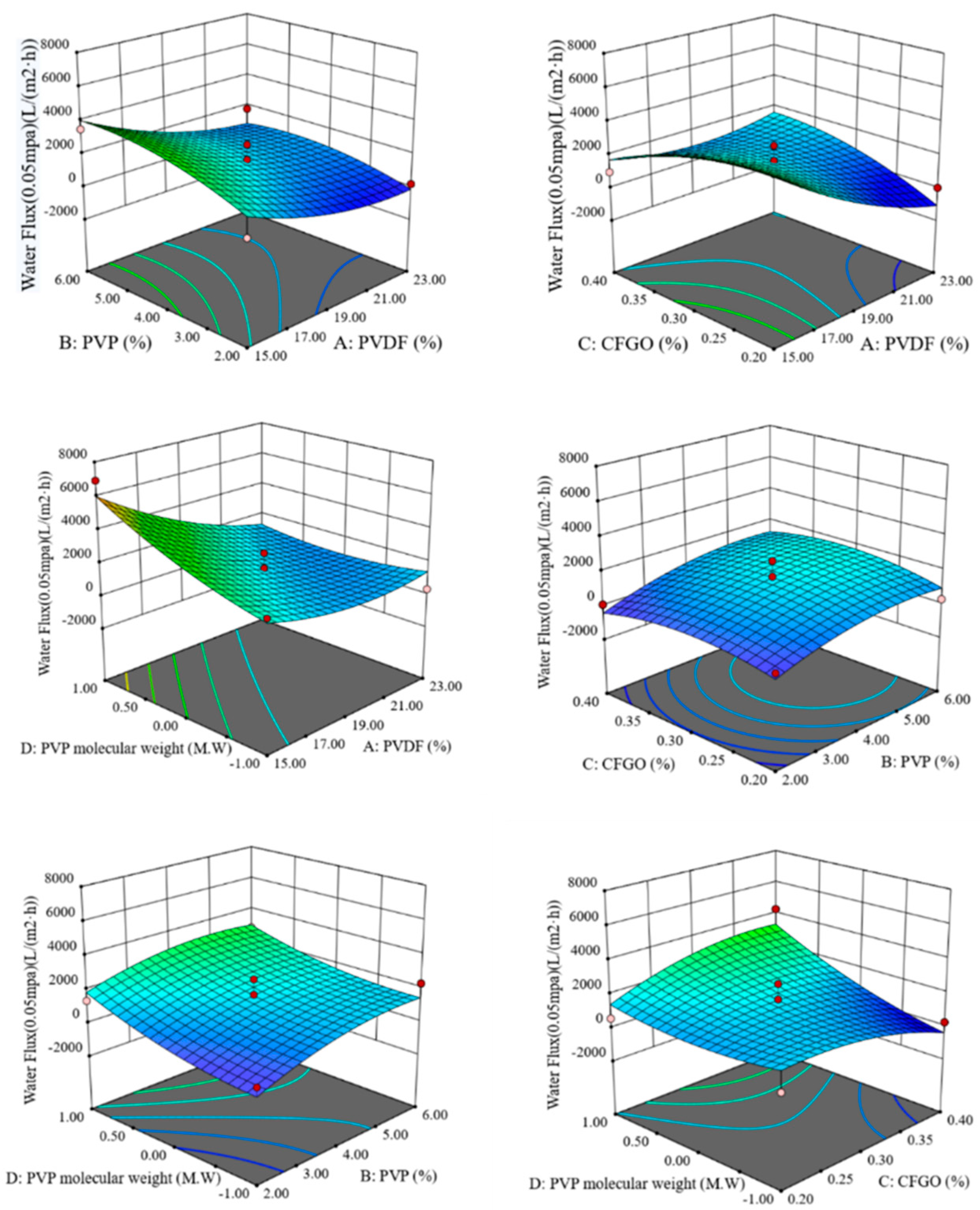
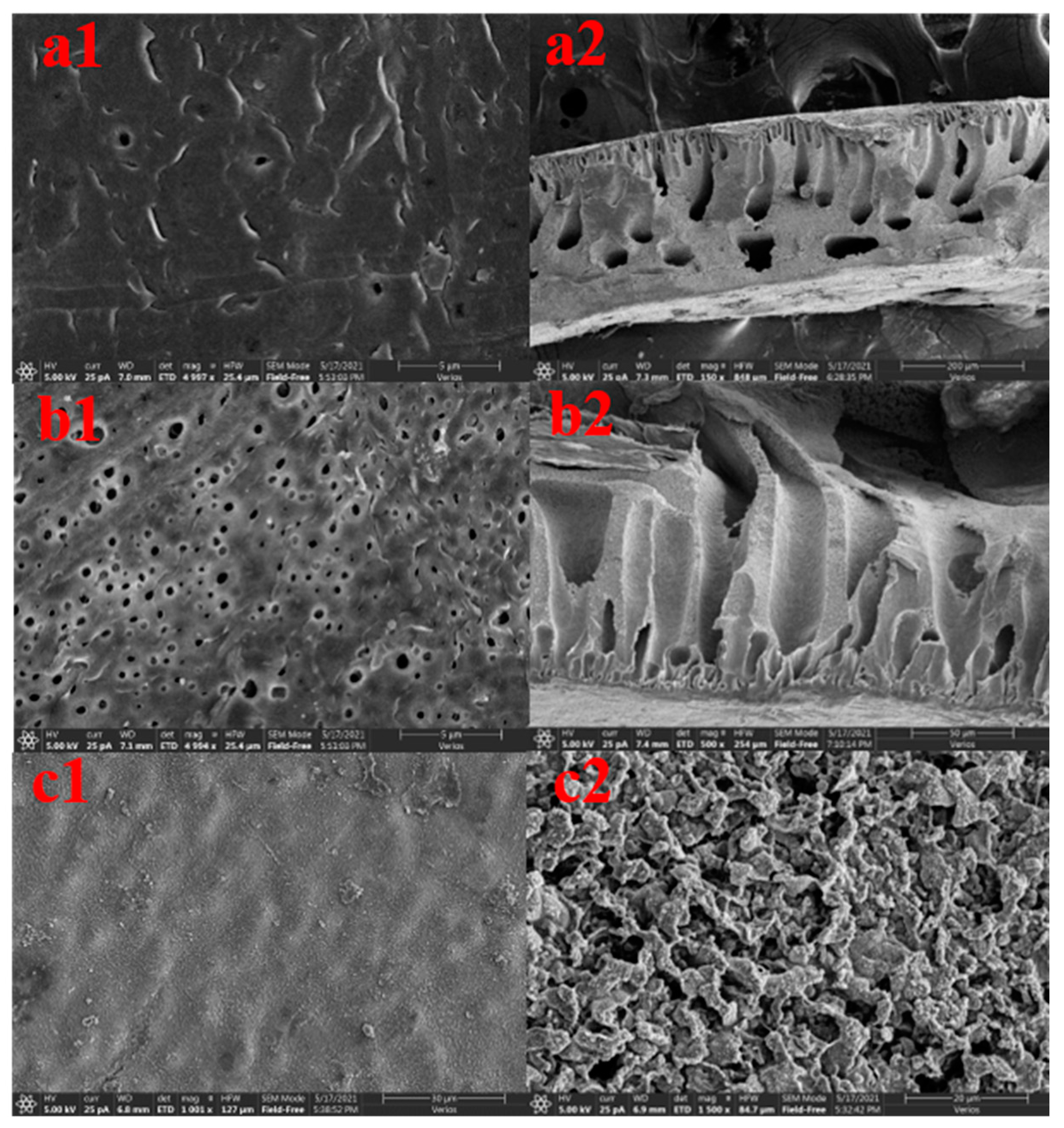
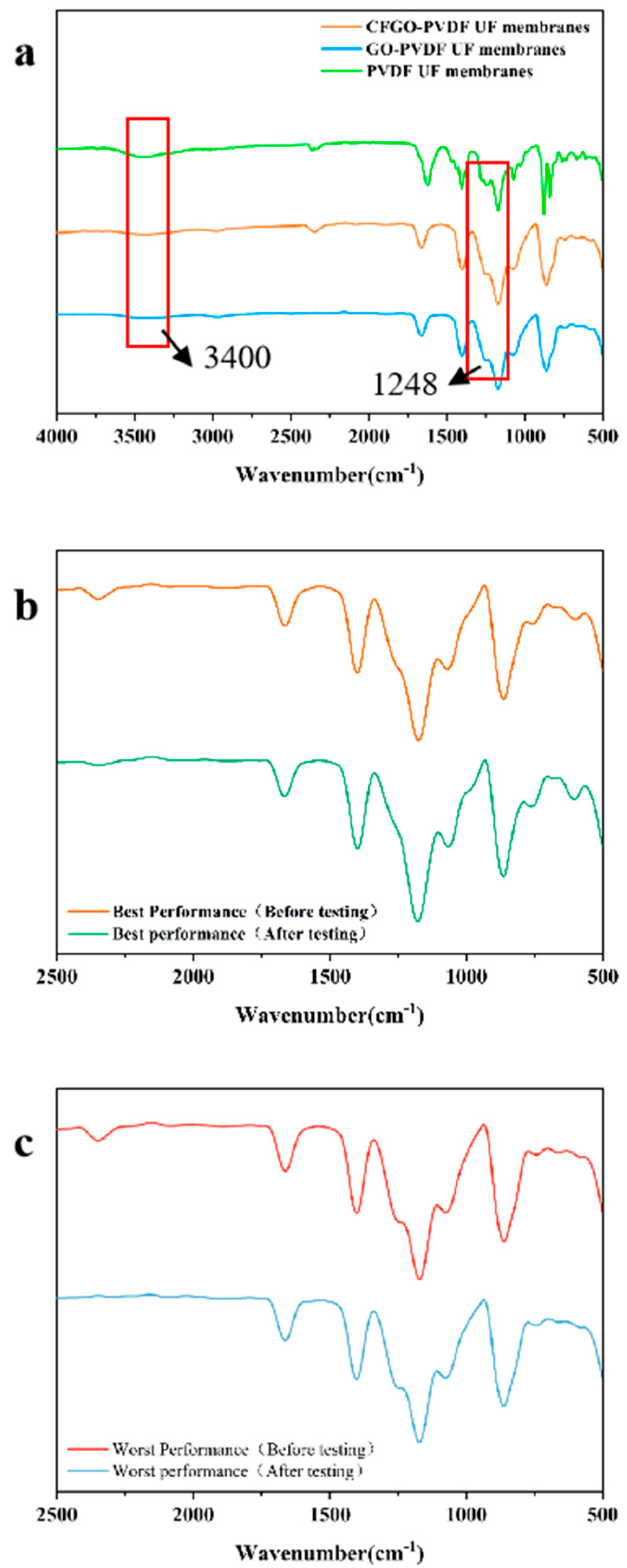
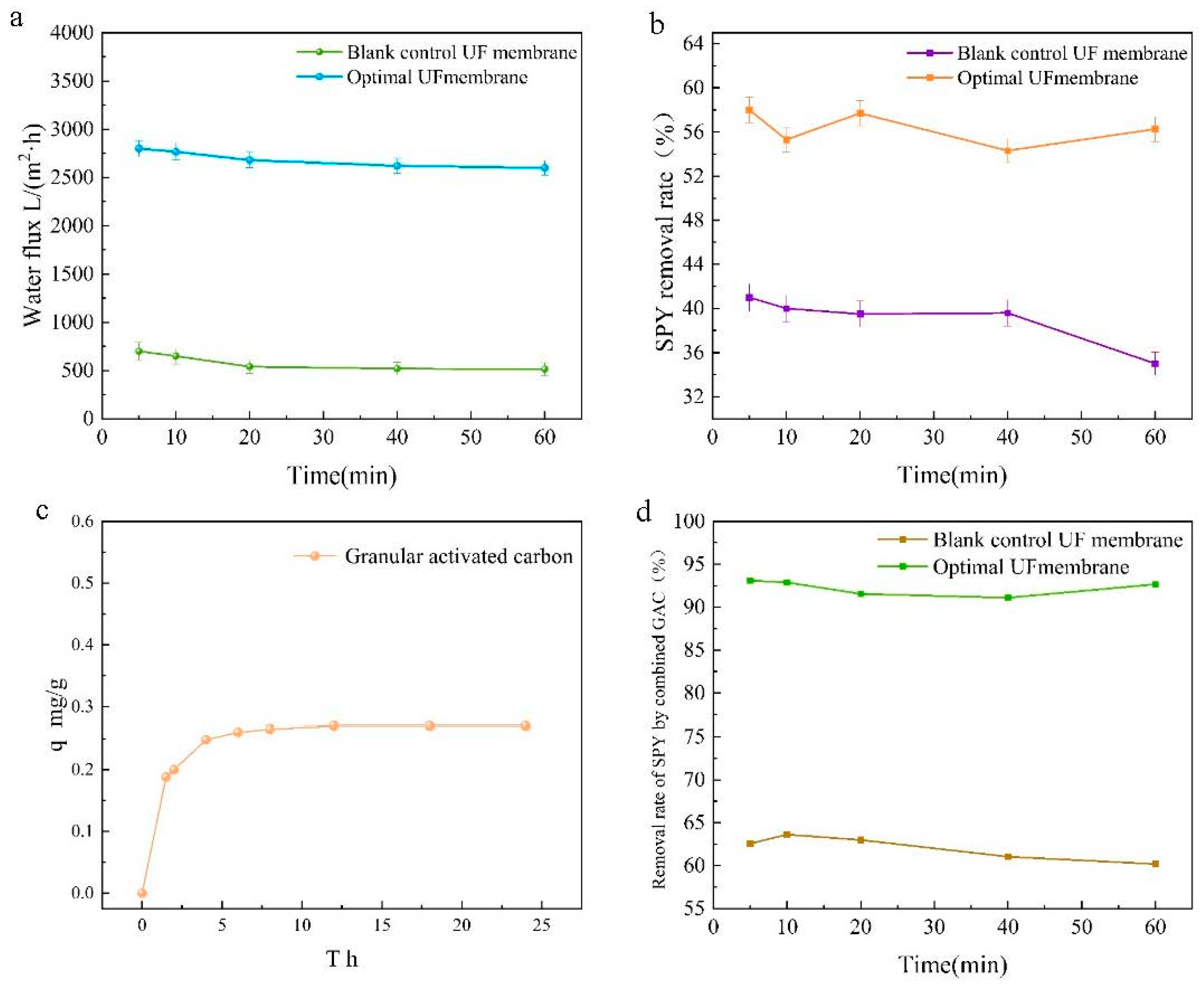
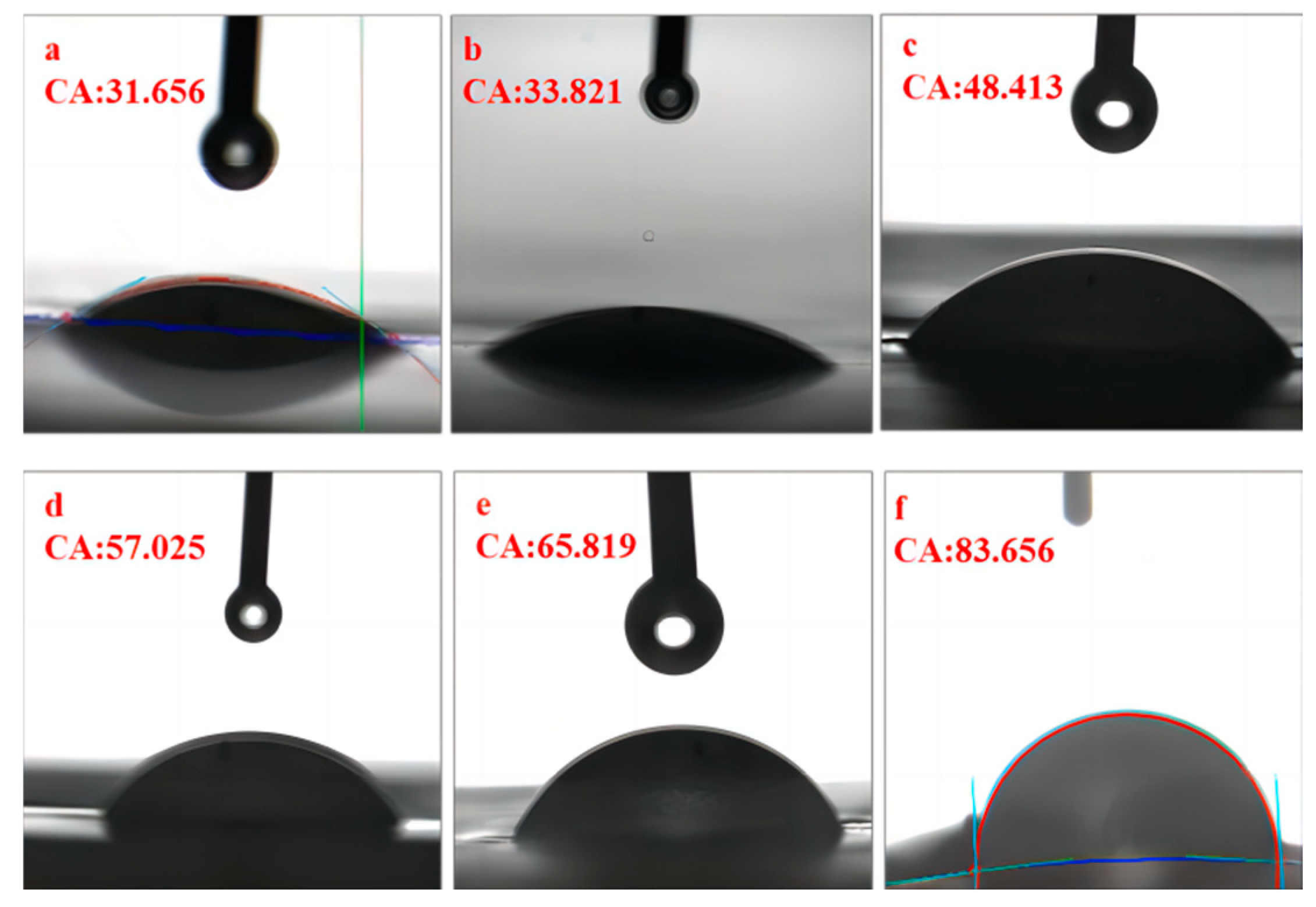
| Level | PVDF Content% | PVP Content% | CFGO Content% | PVP Molecular Weight— |
|---|---|---|---|---|
| −1 | 15 | 2 | 0.2 | 8000 |
| 0 | 19 | 4 | 0.3 | 10,000 |
| 1 | 23 | 6 | 0.4 | 58,000 |
| Std | A:PVDF | B:PVP | C:CFGO | D:PVP Molecular Weight |
|---|---|---|---|---|
| % | % | % | — | |
| 1 | 15 | 2 | 0.3 | 10,000 |
| 2 | 23 | 2 | 0.3 | 10,000 |
| 3 | 15 | 6 | 0.3 | 10,000 |
| 4 | 23 | 6 | 0.3 | 10,000 |
| 5 | 19 | 4 | 0.2 | 8000 |
| 6 | 19 | 4 | 0.4 | 8000 |
| 7 | 19 | 4 | 0.2 | 58,000 |
| 8 | 19 | 4 | 0.4 | 58,000 |
| 9 | 15 | 4 | 0.3 | 8000 |
| 10 | 23 | 4 | 0.3 | 8000 |
| 11 | 15 | 4 | 0.3 | 58,000 |
| 12 | 23 | 4 | 0.3 | 58,000 |
| 13 | 19 | 2 | 0.2 | 10,000 |
| 14 | 19 | 6 | 0.2 | 10,000 |
| 15 | 19 | 2 | 0.4 | 10,000 |
| 16 | 19 | 6 | 0.4 | 10,000 |
| 17 | 15 | 4 | 0.2 | 10,000 |
| 18 | 23 | 4 | 0.2 | 10,000 |
| 19 | 15 | 4 | 0.4 | 10,000 |
| 20 | 23 | 4 | 0.4 | 10,000 |
| 21 | 19 | 2 | 0.3 | 8000 |
| 22 | 19 | 6 | 0.3 | 8000 |
| 23 | 19 | 2 | 0.3 | 58,000 |
| 24 | 19 | 6 | 0.3 | 58,000 |
| 25 | 19 | 4 | 0.3 | 10,000 |
| 26 | 19 | 4 | 0.3 | 10,000 |
| 27 | 19 | 4 | 0.3 | 10,000 |
| 28 | 19 | 4 | 0.3 | 10,000 |
| 29 | 19 | 4 | 0.3 | 10,000 |
| Number | Water Flux (0.05 mpa) L/(m2∙h) | Sulfapyridine Removal Rate | Sulfapyridine Removal Rate after Adding Activated Carbon |
|---|---|---|---|
| 1 | 865.12 | 44.53% | 82.22% |
| 2 | 185.95 | 45.47% | 81.05% |
| 3 | 3501.82 | 44.99% | 84.82% |
| 4 | 1774.88 | 46.59% | 77.61% |
| 5 | 146.45 | 47.80% | 86.46% |
| 6 | 239.67 | 42.13% | 83.99% |
| 7 | 569.59 | 46.31% | 83.52% |
| 8 | 4278.35 | 46.09% | 86.79% |
| 9 | 2381.65 | 53.13% | 78.22% |
| 10 | 330.08 | 51.57% | 78.83% |
| 11 | 6922.31 | 45.00% | 85.80% |
| 12 | 908.43 | 46.98% | 85.95% |
| 13 | 48.26 | 50.87% | 79.02% |
| 14 | 283.47 | 47.60% | 88.21% |
| 15 | 73.31 | 52.51% | 80.04% |
| 16 | 778.51 | 46.87% | 88.81% |
| 17 | 5507.11 | 49.20% | 83.79% |
| 18 | 19.17 | 47.75% | 90.91% |
| 19 | 980.66 | 58.15% | 78.94% |
| 20 | 693.72 | 51.06% | 84.63% |
| 21 | 146.94 | 48.59% | 86.59% |
| 22 | 2289.92 | 52.71% | 83.71% |
| 23 | 1353.06 | 47.39% | 76.22% |
| 24 | 2800.17 | 60.37% | 83.84% |
| 25 | 860.5 | 57.59% | 91.89% |
| 26 | 1613.22 | 56.96% | 89.69% |
| 27 | 1348.76 | 56.65% | 94.29% |
| 28 | 2584.96 | 58.82% | 88.76% |
| 29 | 1666.44 | 56.66% | 89.49% |
| Source of Variance | Sum of squares | Degree of Freedom | Mean Square | F-Value | p-Value | Influence Degree |
|---|---|---|---|---|---|---|
| Models | 6.46 | 14.00 | 4.62 | 3.91 | 0.0078 | ** |
| A-PVDF | 2.20 | 1.00 | 2.20 | 18.62 | 0.0007 | ** |
| B-PVP | 6.39 | 1.00 | 6.39 | 5.41 | 0.0356 | * |
| C-CFGO | 1.84 | 1.00 | 1.84 | 0.02 | 0.9024 | |
| D-PVP molecular weight | 1.06 | 1.00 | 1.06 | 9.00 | 0.0095 | ** |
| AB | 2.74 | 1.00 | 2.74 | 0.23 | 0.6373 | |
| AC | 6.76 | 1.00 | 6.76 | 5.72 | 0.0313 | * |
| AD | 3.92 | 1.00 | 3.92 | 3.32 | 0.0898 | |
| BC | 5.52 | 1.00 | 5.52 | 0.05 | 0.8320 | |
| BD | 1.21 | 1.00 | 1.21 | 0.10 | 0.7536 | |
| CD | 3.27 | 1.00 | 3.27 | 2.77 | 0.1185 | |
| A2 | 2.80 | 1.00 | 2.80 | 2.37 | 0.1463 | |
| B2 | 2.26 | 1.00 | 2.26 | 1.91 | 0.1887 | |
| C2 | 2.74 | 1.00 | 2.74 | 2.32 | 0.1500 | |
| D2 | 1.28 | 1.00 | 1.28 | 1.08 | 0.3163 | |
| Residuals | 1.65 | 14.00 | 1.18 | |||
| Loss of proposed items | 1.50 | 10.00 | 1.50 | 3.78 | 0.1060 | |
| Error term | 1.58 | 4.00 | 3.96 | |||
| Total | 8.12 | 28.00 |
| Parameters | PVDF UF Membrane | CFGO UF Membrane |
|---|---|---|
| Surface thickness (mm) | 0.3 | 0.3 |
| Main Materials | PVDF | PVDF, CFGO Pellets |
| Average pore size(nm) | 8–10 | 8–16 |
| Contact angle (°) | 83.7 | 31.6 |
| Cutting molecular weight (Da) | 100,000 Da | 100,000 Da |
| Pure water flux | ||
| L/(m2·h) | 980 | 2912 |
Publisher’s Note: MDPI stays neutral with regard to jurisdictional claims in published maps and institutional affiliations. |
© 2022 by the authors. Licensee MDPI, Basel, Switzerland. This article is an open access article distributed under the terms and conditions of the Creative Commons Attribution (CC BY) license (https://creativecommons.org/licenses/by/4.0/).
Share and Cite
Chen, Y.; Ba, L.; He, Y.; Yi, X. Removal Efficiency of Sulfapyridine from Contaminated Surface Water by Carboxylated Graphene Oxide Blended PVDF Composite Ultrafiltration Membrane with Activated Carbon. Polymers 2022, 14, 4779. https://doi.org/10.3390/polym14214779
Chen Y, Ba L, He Y, Yi X. Removal Efficiency of Sulfapyridine from Contaminated Surface Water by Carboxylated Graphene Oxide Blended PVDF Composite Ultrafiltration Membrane with Activated Carbon. Polymers. 2022; 14(21):4779. https://doi.org/10.3390/polym14214779
Chicago/Turabian StyleChen, Yuliang, Libo Ba, Yini He, and Xuesong Yi. 2022. "Removal Efficiency of Sulfapyridine from Contaminated Surface Water by Carboxylated Graphene Oxide Blended PVDF Composite Ultrafiltration Membrane with Activated Carbon" Polymers 14, no. 21: 4779. https://doi.org/10.3390/polym14214779
APA StyleChen, Y., Ba, L., He, Y., & Yi, X. (2022). Removal Efficiency of Sulfapyridine from Contaminated Surface Water by Carboxylated Graphene Oxide Blended PVDF Composite Ultrafiltration Membrane with Activated Carbon. Polymers, 14(21), 4779. https://doi.org/10.3390/polym14214779







